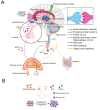Chronic stress as an emerging risk factor for the development and progression of glioma
- PMID: 38238191
- PMCID: PMC10876262
- DOI: 10.1097/CM9.0000000000002976
Chronic stress as an emerging risk factor for the development and progression of glioma
Abstract
Gliomas tend to have a poor prognosis and are the most common primary malignant tumors of the central nervous system. Compared with patients with other cancers, glioma patients often suffer from increased levels of psychological stress, such as anxiety and fear. Chronic stress (CS) is thought to impact glioma profoundly. However, because of the complex mechanisms underlying CS and variability in individual tolerance, the role of CS in glioma remains unclear. This review suggests a new proposal to redivide the stress system into two parts. Neuronal activity is dominant upstream. Stress-signaling molecules produced by the neuroendocrine system are dominant downstream. We discuss the underlying molecular mechanisms by which CS impacts glioma. Potential pharmacological treatments are also summarized from the therapeutic perspective of CS.
Copyright © 2024 The Chinese Medical Association, produced by Wolters Kluwer, Inc. under the CC-BY-NC-ND license.
Conflict of interest statement
None.
Figures



Similar articles
-
The role of glioma stem cells in glioma tumorigenesis.Front Biosci (Landmark Ed). 2014 Jan 1;19(5):818-24. doi: 10.2741/4249. Front Biosci (Landmark Ed). 2014. PMID: 24389226 Review.
-
Phenotypic Transition as a Survival Strategy of Glioma.Neurol Med Chir (Tokyo). 2016 Jul 15;56(7):387-95. doi: 10.2176/nmc.ra.2016-0077. Epub 2016 May 11. Neurol Med Chir (Tokyo). 2016. PMID: 27169497 Free PMC article. Review.
-
Glioma models.Biochim Biophys Acta. 2001 Aug 31;1551(1):M19-27. doi: 10.1016/s0304-419x(01)00027-0. Biochim Biophys Acta. 2001. PMID: 11553418 Review.
-
Communication of Glioma cells with neuronal plasticity: What is the underlying mechanism?Neurochem Int. 2020 Dec;141:104879. doi: 10.1016/j.neuint.2020.104879. Epub 2020 Oct 14. Neurochem Int. 2020. PMID: 33068685 Review.
-
STAT Signaling in Glioma Cells.Adv Exp Med Biol. 2020;1202:203-222. doi: 10.1007/978-3-030-30651-9_10. Adv Exp Med Biol. 2020. PMID: 32034715 Review.
Cited by
-
Overcoming temozolomide resistance in glioma: recent advances and mechanistic insights.Acta Neuropathol Commun. 2025 Jun 5;13(1):126. doi: 10.1186/s40478-025-02046-4. Acta Neuropathol Commun. 2025. PMID: 40468460 Free PMC article. Review.
-
Xenon gas as a potential treatment for opioid use disorder, alcohol use disorder, and related disorders.Med Gas Res. 2025 Jun 1;15(2):234-253. doi: 10.4103/mgr.MEDGASRES-D-24-00063. Epub 2025 Jan 13. Med Gas Res. 2025. PMID: 39812023 Free PMC article. Review.
References
-
- Sung H Ferlay J Siegel RL Laversanne M Soerjomataram I Jemal A, et al. . Global Cancer Statistics 2020: GLOBOCAN Estimates of Incidence and Mortality Worldwide for 36 Cancers in 185 Countries. CA Cancer J Clin 2021;71:209–249. doi: 10.3322/caac.21660. - PubMed
-
- Weller M Wick W Aldape K Brada M Berger M Pfister SM, et al. . Glioma. Nat Rev Dis Primers 2015;1:15017. doi: 10.1038/nrdp.2015.17. - PubMed
Publication types
MeSH terms
LinkOut - more resources
Full Text Sources
Medical

